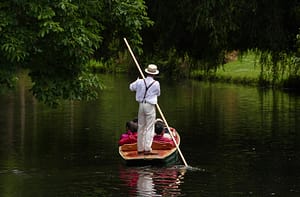Avon River
With a length of 14 kilometres (8.7 miles), the Avon River meanders right through Christchurch, and out into the Pacific Ocean via the Avon Heathcote Estuary. Also known by the Māori name Ōtākaro, meaning ‘the place of a game’, the river was given its English name in honour of the Scottish Avon. River punting is one of the key attractions the Avon is renowned for.
The TranzAlpine Train
Travelling from Christchurch to Greymouth, the TranzAlpine rail journey is a definite must-do for those who want to soak up the South Island’s stunning alpine landscapes. The pleasant, five-hour train ride operates on a daily basis, traversing the Canterbury Plains and the Southern Alps as it ventures towards the South Island’s West Coast region.
Port Hills
Port Hills is named as such because it is composed of a series of hills that lie between Christchurch and the port of Lyttelton. These hills are an important recreation site for locals, and consist of various mountain bike tracks, public parks and reserves. They also extend across several of the city’s suburbs, including Sumner, Cashmere, Mt Pleasant, and Heathcote Valley.
Bridge of Remembrance
The Bridge of Remembrance is one of the two main war memorial monuments in Christchurch. The bridge, which links Oxford and Cambridge Terraces to Cashel Street over the Avon River, was opened on 11 November 1924 in dedication of all those who fought in the First World War. It temporarily closed for repairs in 2013, opening to the public again on 25 April 2016.
Awaroa/Godley Head
Godley Head, known to Māori as Awaroa, is a prominent headland at the entrance of the Lyttelton Harbour. It is home to a distinguished World War II coastal defence battery, which is renowned for being a nationally significant heritage site, as well as a network of scenic walking trails that are nicely complemented by the area’s marine wildlife.
Victoria Clock Tower
The Victoria Clock Tower was designed by Benjamin Mountfort under the commission of the Canterbury Provincial Council. It was made in England in 1860, and was a temporary fixture of the Provincial Buildings before becoming a monument to mark Queen Victoria’s diamond jubilee. The Clock Tower was relocated once again in 1930 to Victoria Street, where it continues to reside today.
Cardboard Cathedral
The Cardboard Cathedral was designed by Shigeru Ban as a temporary replacement for the earthquake-torn Christ Church Cathedral. The transitional home of the Anglican Diocese of Christchurch opened its doors in 2013, and is made up of 60-metre (24-inch) diameter cardboard tubes, a polycarbon roof, shipping container walls, and triangular stained glass windows.
Sumner Beach
Sumner Beach is practically an icon among Christchurch locals, who like to spend the summer days basking at its beauty as they soak up sunshine. The beach lies some 10 kilometres (6.2 miles) southwest of the city, stretching to Cave Rock (which is best viewed at low tide) as well as Scarborough and Taylor’s Mistake beaches.
Riccarton House
Riccarton House is an elegant Victorian/Edwardian homestead that is surrounded by manicured lawns, mature trees, a series of gardens and native plants, as well as the River Avon. It was built in three stages – in 1856, 1874 and 1900 respectively – for the Deans family, whose members are widely recognised as the main pioneers of the Canterbury region.
Willowbank Wildlife Reserve
The Willowbank Wildlife Reserve was established in 1974 by the Willis family, who still own it today, and is home to 50 different animal species. Along with its ongoing efforts to protect New Zealand wildlife, the reserve also brings the local Māori culture to the forefront. Ko Tane is an educational experience hosted by Willowbank that provides a glimpse into the lives of the Ngāi Tahu people before the arrival of European settlers to the South Island.
Christchurch Tramway
Christchurch’s heritage trams take their passengers on a guided journey across the city’s best landmarks and must-visit attractions. A full-day ticket allows visitors to hop on and off as they please, so that they can enjoy the various sites around the 17 stops on the tramway route. If you want to add a unique dining experience into the mix, opt for one of the Tramway Restaurant tours.
Isaac Theatre Royal
The Isaac Theatre Royal opened in 1908, and is New Zealand’s only operational Edwardian-style theatre. It replaced another Theatre Royal on the same street, which had actually been built in the same place as the theatre’s first incarnation. Along the course of its lifetime the Isaac Theatre Royal has undergone various refurbishments and renovations, including a massive post-quake restoration pursuit which was completed in 2014.
New Regent Street
New Regent Street is a historic pedestrian mall that is characterised by its stunning Spanish Mission style buildings. It originally opened in 1932, and continues to be highly renowned for its pastel-coloured structures and ornate facades. The street relies on several boutique shops and cafés to liven up Christchurch’s urban landscapes.

